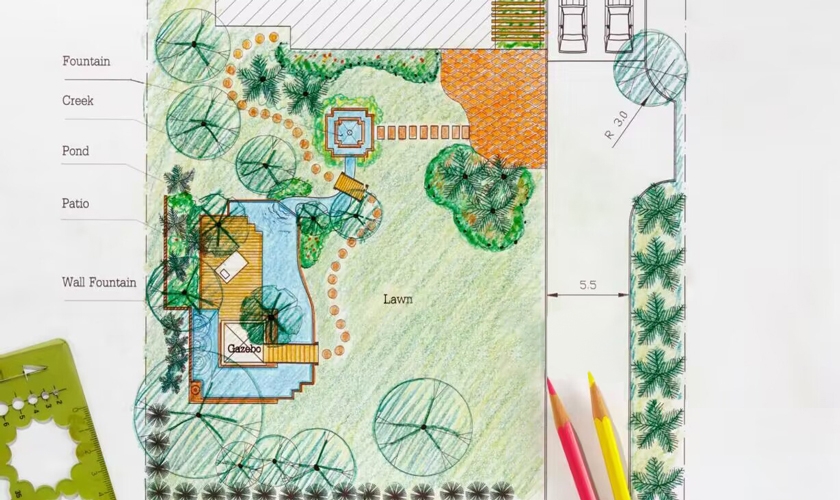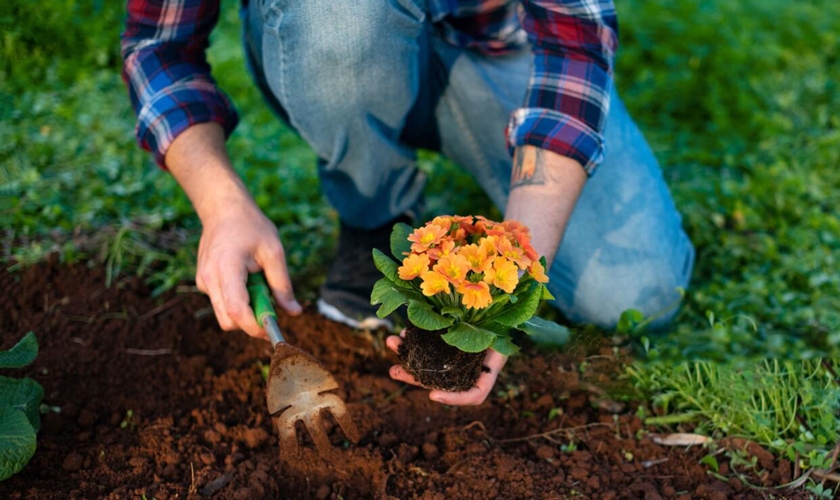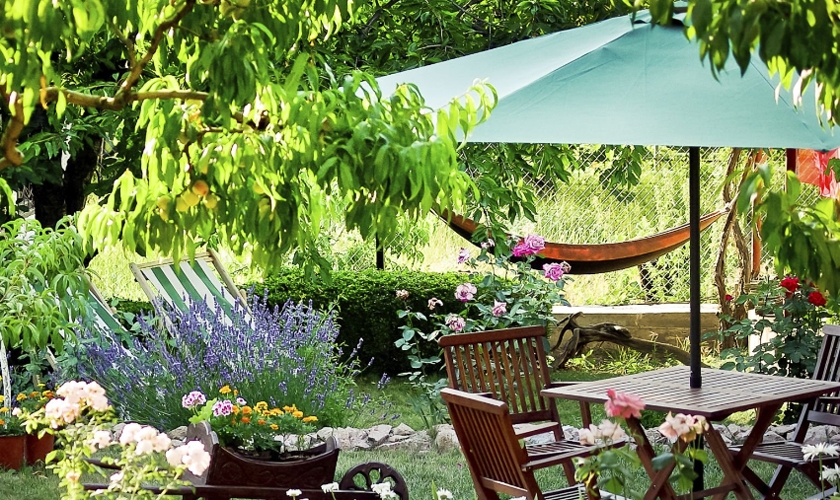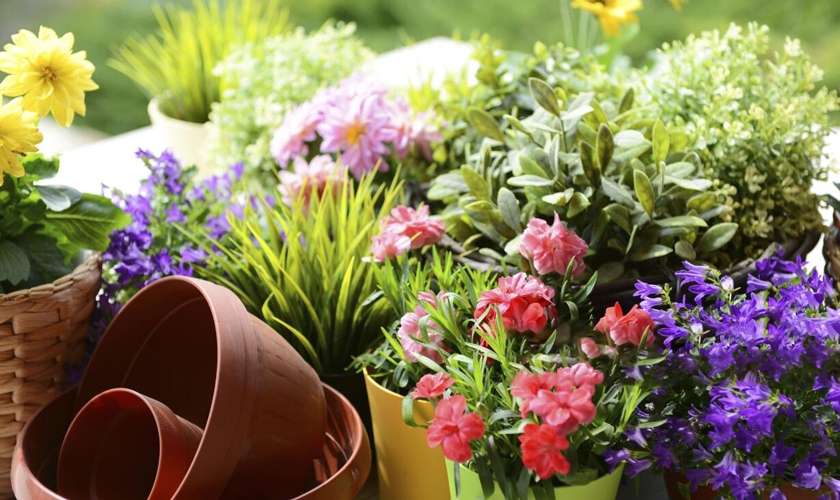Creating a peaceful garden space can not only enhance the beauty of your home but also provide a comfortable place for family and friends to relax. With proper planning and the use of suitable tools, you can easily achieve this goal. This article will detail how to use various garden tools and decorative elements to create an ideal garden space.
Space Planning and Layout
Space planning is the first step in creating a garden. A good layout can enhance the functionality and aesthetics of the garden. First, draw a simple garden plan, marking main areas such as flower beds, lawns, recreational areas, and vegetable gardens. Consider the size and relative position of each area to ensure that each can fully utilize sunlight and water resources. When drawing the plan, use sketch paper and a pencil to mark the main areas and paths.
Plan the paths within the garden to ensure easy walking. Use garden forks and hand pruners to clear weeds and excess plants from the paths. You can choose pebbles, wood chips, or bricks to pave the paths, which are both beautiful and practical. When planning the paths, consider how to connect the different areas of the garden so that each area is easily accessible.
Divide the garden into different functional areas according to your needs. For example, there can be an area for growing flowers, an area for growing vegetables and herbs, and a recreational area. Each functional area should have clear boundaries, which can be marked with flower bed edges, fences, or plants.

Plant Selection and Planting
Choosing the right plants is key to creating a beautiful garden. Select suitable plant types for different areas to ensure they can grow healthily in your climate conditions.
Flower Bed and Lawn Areas
In flower bed and lawn areas, you can plant colorful flowers and durable lawns. Use small shovels and small rakes from the planting tool set to prepare the planting bed. First, use a garden shovel to loosen the soil, ensuring it is loose and fertile. You can add organic fertilizers or compost to improve soil quality. Choose flowers suitable for the local climate, such as roses, chrysanthemums, and lavender. Arrange the planting positions according to the growth habits of the flowers to ensure each plant has enough growth space and sunlight. Choose durable and easy-to-maintain lawn varieties such as Bermuda grass or St. Augustine grass. Use a rake to evenly spread the grass seeds and cover them lightly with a thin layer of soil. Water regularly to keep the soil moist and promote seed germination.
Small Spaces and Container Gardening
For small spaces or to add some three-dimensionality to the garden, you can choose grow bags and pots. Select containers of suitable size for the plants, ensuring the containers have enough drainage holes. Grow bags and pots are good choices and can be moved as needed. Use high-quality potting soil mixed with organic fertilizer to improve the soil's nutrients and drainage. Choose plants suitable for container planting, such as herbs, vegetables, and small flowers. Place the plants in the containers, fill them with soil, and press them gently. Water regularly to keep the soil moist but not waterlogged. Place the containers in a sunny location to ensure the plants receive enough sunlight. If necessary, adjust the container positions according to seasonal and light changes.

Adding Decorative Elements
Decorative elements not only enhance the visual appeal of the garden but also increase its functionality. By arranging these elements cleverly, you can make the garden more beautiful and practical. Outdoor solar lights are very popular decorative and lighting tools in modern gardens. They are environmentally friendly and easy to install. Install solar lights on both sides of the garden paths to illuminate the walkways and add beauty to the night landscape. Choose waterproof solar lights to ensure they work normally in various weather conditions. Use solar lights to highlight specific flower beds, sculptures, or water features, emphasizing the garden's unique areas. You can choose spotlights or landscape lights to create different light and shadow effects. Select uniquely shaped solar lights, such as lanterns or flower shapes light, to decorate the recreational areas, creating a warm atmosphere. These lights not only provide illumination at night but also serve as decorations during the day.
Creating a comfortable outdoor recreational area is a dream for many garden enthusiasts. Choose a suitable patio umbrella based on the overall style of the garden and the size of the recreational area. Umbrellas not only provide shade but also protect furniture and plants from direct sunlight. Consider choosing adjustable height and angle umbrellas for increased flexibility. Select a set of comfortable patio furniture such as sofas, chairs, and coffee tables to place under the umbrella. Ensure the furniture material is durable and easy to clean, such as waterproof wicker, aluminum alloy, or wood furniture. Add some soft cushions and pillows for extra comfort. Add decorative elements around the recreational area, such as rugs, outdoor paintings, and floral arrangements. Choose weather-resistant decorations to ensure they remain beautiful in outdoor environments.
Garden ornaments are small but decorative items such as sculptures, wind chimes, and bird baths. Choose small sculptures or decorations that match the garden style and place them around flower beds, lawns, or recreational areas. These ornaments can add an artistic touch to the garden and attract people's attention. Hang some wind chimes or ornaments on tree branches or umbrellas to add a lively atmosphere to the garden. Wind chimes produce pleasant sounds in the breeze, creating a sense of tranquility and relaxation. Place a bird bath or bird feeder in the garden to attract birds to play and feed. This not only increases the garden's vitality but also provides you with the pleasure of bird watching.

Maintenance and Care
Maintaining a clean and healthy garden requires regular maintenance and care. Proper management can ensure healthy plant growth and lasting beauty in the garden. Proper watering is crucial for plant health. Different plants have different water requirements, so adjust accordingly. Use watering cans or irrigation tools to manually water plants that need special care. Watering in the early morning or evening is best to reduce water evaporation and plant heat stress. For larger gardens, consider installing an automatic irrigation system such as drip or sprinkler systems. These systems can water automatically according to set times and frequencies, ensuring even water supply to plants, especially suitable for busy garden owners. Set up a rainwater collection system to collect rainwater for garden irrigation. This is not only environmentally friendly but also saves on water costs. You can choose to install rain barrels or underground storage systems.
Regular pruning and cleaning can maintain healthy plant growth and garden cleanliness. Use electric and manual pruners to regularly prune trees, shrubs, and flowers. Pruning can promote plant growth, prevent pests, and maintain a beautiful shape. Keep the pruners clean and sharp to avoid damaging plants. Use garden gloves, rakes, and leaf bags to regularly clean up fallen leaves and weeds in the garden. Fallen leaves and weeds not only affect the aesthetics but also may breed pests. Composting pruned leaves and branches can be recycled. Regularly check plants and promptly deal with pests. Use organic pesticides or manually remove diseased leaves and branches to avoid using harmful chemicals.

Environmental Protection and Sustainability
In modern gardening, environmental protection and sustainability are very important themes. By adopting environmentally friendly methods and tools, you can protect the environment and create a healthier, more sustainable garden.
Solar-Powered Tools
Using solar-powered tools is a key way to achieve garden environmental protection and sustainability. These tools use solar energy as a power source, reducing dependence on electricity and being easy to operate.
Solar Lights
Outdoor solar lights are common environmentally friendly lighting choices in gardens. They not only save energy but also reduce carbon emissions. Solar lights absorb solar energy during the day and automatically light up at night. Modern solar lights usually have light sensors that can automatically turn on and off according to changes in light. Solar lights are very easy to install without wiring. Choose waterproof and dustproof solar light models to ensure they work normally in various weather conditions. Regularly clean the dust and dirt on the lights to ensure the efficient operation of the solar panels. Use solar lights to illuminate garden paths, flower beds, and other important areas at night, which are both beautiful and practical. Choose solar lights in different colors and shapes to enhance the garden's visual appeal.
Solar Irrigation Systems
Solar irrigation systems use solar energy to provide power for automatic irrigation in the garden. These systems are not only environmentally friendly but also save a lot of labor and time. A typical solar irrigation system includes solar panels, water pumps, controllers, and sprinklers. Solar panels power the system during the day, and the controller activates the water pump to irrigate at set times and frequencies. When installing solar panels, choose a sunny location. Arrange the water pump and sprinklers in the areas that need irrigation, and set the controller's working time and frequency according to the plants' water needs. Solar irrigation systems can precisely control irrigation, avoiding overwatering and saving water. Combining a rainwater collection system with the irrigation system can further improve water use efficiency.
Reusable Containers and Materials
Choosing reusable containers and materials can reduce waste and protect the environment. Grow bags are flexible, reusable planting containers suitable for various plants. 3/5/10/20/50/100 Gallon grow bag options available. They are usually made of breathable, durable non-woven fabric, which helps plant roots breathe and grow. They are lightweight and easy to move and manage. Grow bags are easy to use; just fill them with the right amount of soil and plants. They usually have drainage holes at the bottom to prevent waterlogging. After use, they can be cleaned and dried for reuse. Grow bags are suitable for small gardens, balconies, and rooftop gardens, where they can grow vegetables, herbs, and flowers. Their mobility allows plants to be moved according to sunlight and seasonal changes.

Biodegradable Materials
In gardening, using biodegradable materials can reduce environmental impact. Choose plant fiber or other biodegradable materials for flower pots, which can naturally degrade after use, reducing plastic pollution. Use organic mulches such as straw, bark, or fallen leaves to keep the soil moist, prevent weed growth, and provide nutrients to the soil after decomposition. In gardening, recycle and reuse various materials as much as possible to reduce waste. Use kitchen waste and garden debris to make compost, providing natural fertilizer for plants and improving soil structure and fertility. Old plastic bottles, cans, etc., can be repurposed as planting containers or watering tools, creatively reusing everyday waste.
Water Resource Management
Proper water resource management is key to sustainable garden development. Install a rainwater collection system to effectively use natural rainfall and reduce tap water usage. Set up rain barrels or underground storage tanks to collect rainwater from roofs or other surfaces. Rain barrels usually have filters to prevent debris from entering the storage system. Collected rainwater can be used for garden irrigation, patio cleaning, and outdoor facilities. The minerals in rainwater are beneficial for plant growth. Drip irrigation systems are efficient irrigation methods that deliver low-flow water directly to plant roots, reducing water waste. A drip irrigation system includes pumps, pipes, drippers, and filters. Pumps deliver water to the pipes, and drippers slowly release water to plant roots. When installing a drip irrigation system, ensure each dripper accurately covers the plant roots. Regularly check and clean the filters to prevent clogging and ensure normal system operation. Drip irrigation systems can precisely control water amounts, preventing evaporation and leakage, making them ideal for arid areas and water-saving gardens.
Creating an environmentally friendly and sustainable garden not only enhances the garden's beauty and functionality but also contributes to environmental protection. By using solar-powered tools, reusable containers and materials, and managing water resources wisely, you can create a beautiful and eco-friendly garden. Whether choosing solar lights, grow bags, or installing rainwater collection and drip irrigation systems, each eco-friendly measure supports sustainable garden development. A well-designed and managed garden is not only a family leisure space but also a reflection of an eco-friendly lifestyle.

